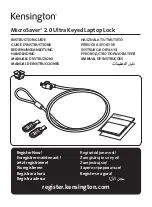
11
3.3 The Orientation of the Polaris:
As the Polaris is not located exactly at the North Celestial Pole, we can see it orbits the North
Celestial Pole in a polar scope. The large circle seen in the center of the pattern in
Fig. 3.2a
is
a representation of the Polaris’ orbit around the North Celestial Pole. When performing the po-
lar alignment process, it is necessary to determine the orientation of the Polaris on the circle.
We can use the following 2 methods to get the orientation:
1.
Locate both the Polaris and the Kochab in the sky near the North Celestial Pole. The di-
rection from the Polaris to the Kochab can be used as proximity of the orientation of the
Polaris in the polar scope. Put the Polaris to the same direction on the large central circle
in the polar scope to finish the polar alignment.This method is somewhat less accurate.
2.
At the end of the initialization of the SynScan hand control, after entering the proper lo-
cal longitude, latitude, date, time, and daylight-saving time, the SynScan hand controller
will display the message: “Polaris Position in P.Scope=HH:MM”. Imagine the larger circle
in
Fig. 3.2a
as a clock’s face with 12:00 at the top, with the current time pointing to the
“HH:MM”. The orientation of the hour hand of the clock represents the orientation of the
Polaris in the polar scope. Put the Polaris to the same orientation on the large circle to
finish the polar alignment.
Polaris position also changes as time passes. The reticle in Fig. 3.2a displays 3 circles to
represent Polaris’s orbit in year 2012, 2020 and 2028. It also gives sub-dials at 0, 3, 6, and
9 o’clock position for year 2016, 2024 and 2032. An engraving labeled with the above years
is also displayed on the right of the FOV for memo purpose. When doing polar alignment in
Northern hemisphere, the user should put Polaris on the correct circle corresponding to the
present year for better alignment precision.
PART III: POLAR ALIGNMENT
3.4 Align the Polar Scope
Before using the polar scope for polar alignment, the polar scope itself must be calibrated to
ensure the pattern in the polar scope is aligned to the mount’s R.A. axis. The following steps
will outline how to calibrate the polar scope:
1.
Choose a fixed object (the Polaris at night, or a faraway object in daytime); put the reticle
in the FOV of the polar scope on the object by adjusting the two azimuth adjustment knobs
and the two elevation adjustment bolts.
2.
Rotate the mount in R.A. axis for half a turn. The R.A. dial can be used for an accurate
rotation. Tighten the R.A. clutch after the rotation.
Содержание EQ6-R MOUNT
Страница 1: ...EQ6 R Mount EQ6 R S 201218V1 EN...
Страница 17: ...EQ6 R Mount...


































